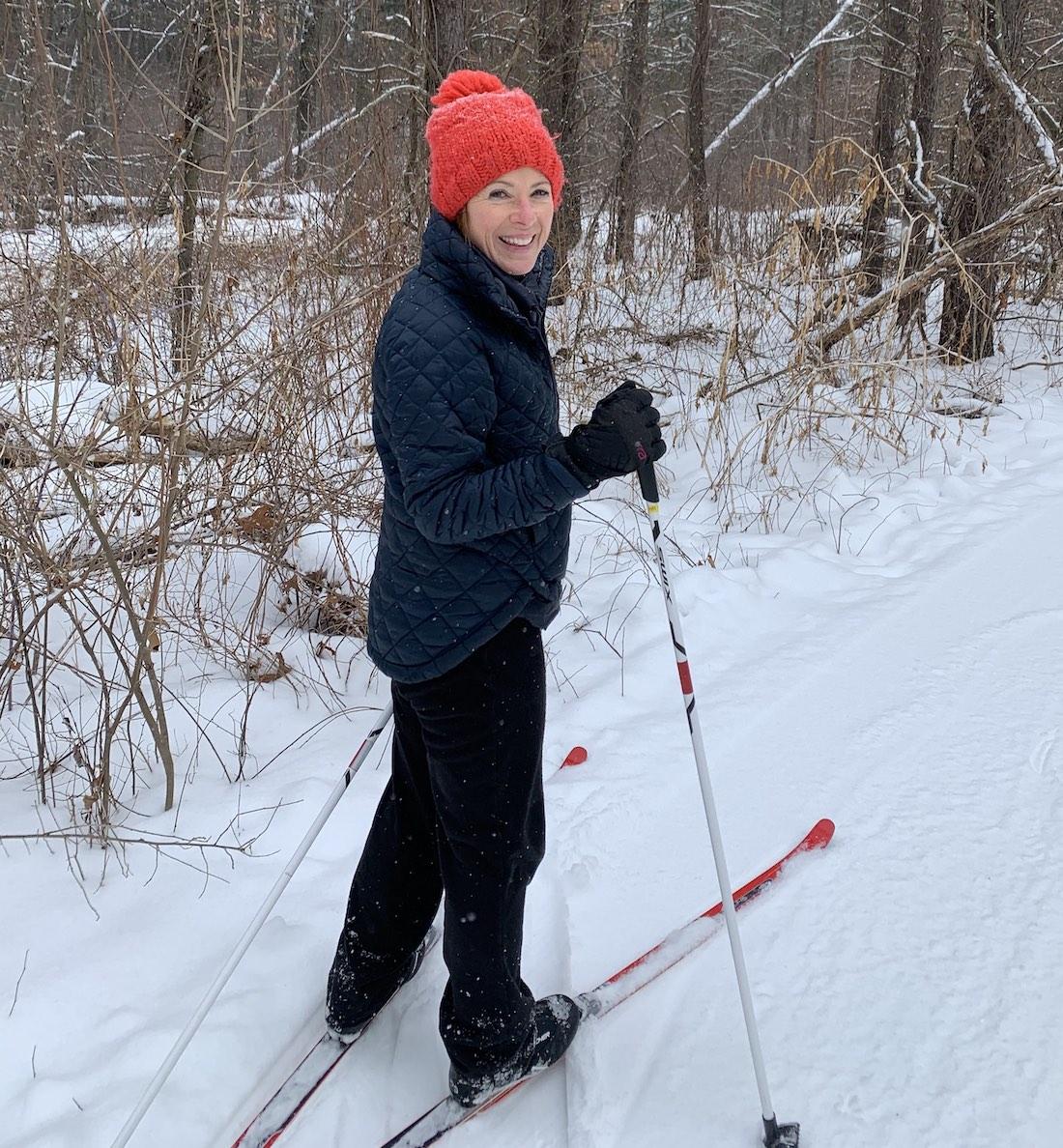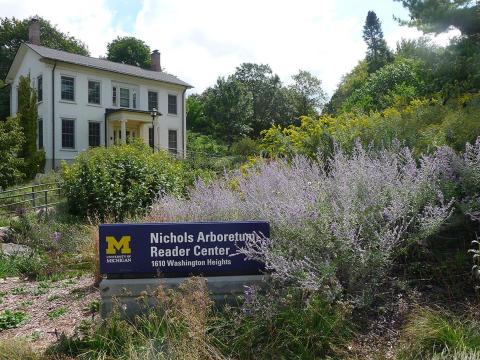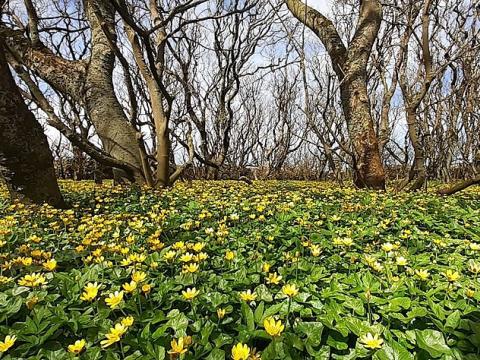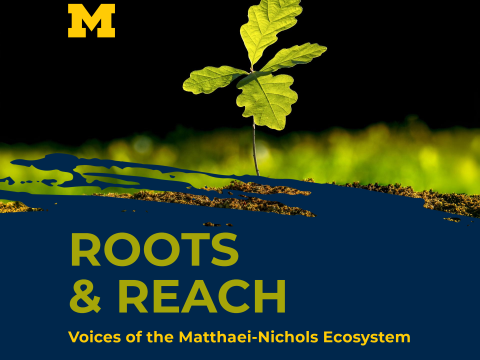Roots and Reach
We are excited to share the inaugural episode of MBGNA's "Roots & Reach" podcast! This episode features a conversation between our Director Tony Kolenic and Lee Smith Bravender - Educator, Horticulturist, and fervent Advocate for Childhood Outdoor Play at MBGNA. In this episode, Lee shares how Nature Play is a crucial element of childhood development, where engagement with natural elements encourages exploration and growth. This form of play is vital not just for developing motor and cognitive skills but also for fostering a strong sense of self and connection to the environment. Embracing Nature Play has the power to shape future generations rooted in environmental stewardship and justice!
You can listen to the podcast here, or read the interview below.
What is Nature Play, who is it for, and what makes it such a useful form of human development?
Certainly, Nature Play is inclusive of many different ways of being outdoors while engaging with, or being in, a state of curiosity and exploration; surely. And, at MBGNA, when we use the language of Nature Play, we are describing something rather specific.
NC Natural Learning Institute at NCState actually has a working definition/framework which really hits the mark for GCG, describing exactly what you’d see for yourself at GCG. In fact, I’m certain that Bob Grese (former MBGNA Director & retired professor at UM’s LA program) and Sara Weiss (GCG’s founding Project Manager) and their team utilized in it the creation of GCG: Nature Play is a designated, managed area in an existing or modified outdoor environment where children of all ages and abilities play and learn by engaging with, and manipulating, on their own terms, diverse natural elements, materials, organisms, and habitats, through open-ended sensory, fine motor, and gross motor experiences. That definition communicates a lot AND it also really describes Matthaei-Nichols approach to Nature Play in the GCG. I’d like to emphasize a couple of things:
This guiding set of principles from NLI, also emphasizes that Nature Play is for everyone, for all children of all ages & abilities – by the way, UNCRC is clear, article 31 articulates the right of the child to play? So, Nature Play is also about nature access and play equity.
Embedded in this framing of Nature Play, is an explicit imperative for natural loose parts – natural loose parts are very important in GCG and other nature play spaces.
The phrase ‘on their own terms’ is important here. In Nature Play spaces, and certainly in GCG, what you’ll see are collections of natural loose parts, and either an invitation to play, and perhaps an open-ended question, an “I wonder why…” There is no desire to “teach” specific facts, rather we offer invitations to explore, to be curious, and to wonder.
This framework works for us.
Regarding Nature Play’s usefulness as a practice supporting healthy human development, well, first, all mammals play – play is thought to have an evolutionary role. And, it’s physical, it’s about our bodies, moving our bodies – and parts of our bodies, and using our body –and parts of our bodies – to move these loose parts, and in doing so, getting to know our bodies in outdoor spaces. When it’s about the bodies, it's also about the mind and cognition, which includes vestibular development, and the sixth sense, proprioception, which is, very basically, the practice of using all of our senses to process and understand sensory input and know our bodies in real time and space. Together, this is all highly aligned with self-regulation, executive functioning. Nature Play also allows for developmentally appropriate risk-taking, again, very formative for executive functioning, and the development of an authentic sense of self.
Returning to the matter of loose parts, Nature Play features lots and lots of manipulatable natural loose parts, and when combined with an environment that is highly permissioned, these conditions provide authentic opportunities for children to follow their own curiosity, to try out some of their their ideas, their hypotheses, based on what they are curious about – so children of different ages and stages of child development – and temperaments – might utilize these same natural loose parts in very different kinds of ways – for infants, that might look like their parents and caregivers to be holding them, singing and talking with them, maybe touching a loose part to feel it’s texture, or leaning into a flower to inhale deeply and experience it’s fragrance; toddler littles might simply move the loose parts around, dragging a stick, rolling a log section, collecting tree cookies and pulling them around in a wagon; at other stages, children might order them according to size, or some other physical characteristic they are discovering. Eventually, these very concrete experiences lead to natural explorations and more intellectual extensions. Older preschoolers, kindergarteners, and elementary aged children, for example, might start to create things with the loose parts: structures of all sizes, risky play affordances, simple machines, artistic expressions. Basically, loose parts pave the way for critical thinking, inviting children to have their own ideas, to create using the loose parts according to their own curiosity, to figure out how to make their own ideas work. So it’s this really powerful set-up for trying and learning, trying and learning, changing something, trying and learning some more. Now we are back to executive functioning practice.
Another angle is that research indicates, strongly, is that children who spend time exploring outdoors, initially with a trusted adult, and then with growing independence, that exploration is basically building a relationship, a knowledge of the outdoors, and they become the children who are most likely to value the outdoors, to love nature, to incorporate earth friendly behaviors into their very sense of self. Which is radically fundamental to a nature centric organization like MBGNA.
While this might not be visible to casual observers, I want to emphasize: scholarship on play identifies at least 16 types of play – GCG provide opportunities to engage in almost all of these types of play; and we also lean on Howard Gardner’s Theory of Multiple Intelligences – many ways to be smart, many ways to know, and GCG offers environments to exercise these many ways of knowing, many types of intelligences, too.
In the best possible expression, Nature Play has many implications and benefits; it’s kind of everything, right?
How did you get into Nature Play, and what about it keeps you invested in the field/worldview?
First, may I say that I understand learning as this helix or cyclical set of experiences. So, all of my crooked path has led me here, to GCG, childhood outdoor play, and advocacy for nature access and play equity.
I played outside a lot as a child, usually unsupervised and in and out of the creek, the fields, the trees, with a pack of other children of differing ages. We had a rather significant range of roam, independent mobility. Yes, and I’m 57 years of age, and that is not so typical of modern children, right? Nor is it entirely representative of my own children's childhoods.
Parenting is another formative experience for me. When my partner and I became parents, we loved being outdoors with our children. We felt strongly about the kids having access & opportunities to play outside, hiking as a family, exploring our community’s natural areas without specific learning objectives, just being together and being outdoors, and playing and exploring and having fun and adventures, right? We were, professionally, aware of the benefits of play and outdoor play, as my partner is a pediatrician and I have long been involved in professional fields centered around human learning. Play is critical to well-being, it's fun, and it’s a way of knowing. Yes, and Terry and I are city dwellers. We live in cities, preferably in downtown parts of cities, and we were living in the west Fenway of Boston and in Durham NC, when the boys were young, and these are urban neighborhoods, and, while there was lots of nature access all around us, there were some limits to my kids’ range of independent roam.
Luckily, we met Martha Lefevre when we first moved to Durham. Martha Lefevre is an amazing human, and a deep influence on my Nature Play practice here at GCG. Martha’s a child development expert who provides very part-time care for small groups of children, several groups of different age groups throughout the day. Kids in her care grow up with her, and with each other – kind of an extended family, really. Martha encouraged me to understand humans as mammals, as part of nature, and, you know what, it’s pretty helpful to understand child development in that way. Martha has this unique point of view, and she is amazing at providing opportunities for the children in her care –from toddlers to teens – to play, play, play, and usually outdoors. Martha is clear that play is the work of childhood, yes? Now, Martha’s House doesn’t have a large outdoor space, but Martha makes it into this amazing outdoor play space that is interesting and engaging to the entire age range of children and youth. It is interesting because children have a great deal of agency in how to use the space, how to play. Martha provides an example, that you don’t have to have a huge outdoor space to have Nature Play, you can provide quality Nature Play, if you develop the mindset for it.
I had a garden design and install business in Durham, NC – gardensmith. I was self-taught, and I knew I would return to university to study landscape architecture or garden design when the time was right; I looked forward to studying at NCState. However, before the time was right, we moved to Colunbus, Ohio. So, I volunteered at OSU’s Chadwick Learning Gardens, and loved it. Eventually I became an overaged undergraduate at OSU, studying a science field for the first time ever. I was studying horticulture and sustainable garden design. In our design labs, we would meet with actual clients. For one of these clients, their top priority regarding their children’s outdoor play space, was to install an exact replica of their own grand home. WTH. Well, I try to meet people where they are, so I knew I needed to be able to bring these parents along to understand that something more authentic and dynamic would support their children’s holistic development; that something dynamic would interest their children across developmental stages. I developed a formula that featured some amount of wild, ungroomed/lightly groomed space, access to natural loose parts, and some level of free agency about what could happen in that wild-ish space. Basically, I was pitching Nature Play.
At the same time, I read a study utilizing statistical modeling, on emerald ash borer caused ash tree death and human mortality as a result of cardiovascular disease, Donovan et al. These researchers found a correlation. What? So that took me down a rabbit hole I continue to happily explore: nature accesses’ affordances to health,resiliency.
When I landed at Matthaei-Nichols, I was invited to dive deeper into Nature Play, develop the physical space of GCG, and, perhaps most importantly, to develop a strong identity for GCG.
So it all knits together, yes? I am where I am meant to be.
How does it inform the Gaffield Children's Garden and your work with Matthaei Botanical Gardens and Nichols Arboretum?
Well, MBGNA is celebrating 15 years of Nature Play at GCG this year! Gaffield Children’s Garden is all in on Nature Play. (Nature Play is just one of the complimentary ways through which MBGNA lives its mission.) At MBGNA, we know the scholarship; we understand that childhood outdoor play is essential, healthy human development, it's a pathway to pro-Earth behavior and Nature connection, and it is a deep practice of powerful, self-directed learning. Everything we provide in GCG is Nature Play. So when you come out to play, you will see lots and lots of natural, foraged loose parts, you will see open-ended invitations to play, to create, to experiment, to wonder, to ask questions. You will see there is no wrong way to play.
Now here’s an important thing: pretty much everything in GCG is easy to replicate, by design. We are modeling Nature Play. Yes, we want families to be able to access Nature Play here, and, even more importantly, we hope they will adapt the play they enjoyed here, to create their own Nature Play for their own home and community spaces, whether that is a home with a yard, an apartment home with a balcony or patio, in their parks, in their school spaces, on their walk to the bus. Nature is all around us, and if we have that mindset of valuing play, we can have Nature Play wherever we are.
I think of Nature Play’s influence in nested layers: the physical space of GCG, the involvement with the UM community, the involvement with the broader community – including growing the Nature Play movement.
Recently we have begun to engage more UM students, through employment, internships, and through an SSO, FGCG. These are opportunities for students, across disciplines, to grow a lens on the benefits of this extraordinary intersection of Nature connection and access, and the value of play. When we understand childhood outdoor play as health, sustainability & pro- environment behavior, and as an important practice of learning, then we can appreciate tha childhood outdoor play/Nature Play has implications for many professional fields and disciplines, right? It’s the personal health disciplines, including social work, it’s the public health disciplines, it’s all the disciplines aligned with environment, and it’s all the disciplines that are aligned with the act of learning – including environmental psychology and educational psychology; it’s for built environment disciplines, and it has implications for justice related fields as we know that quality nature access and play equity is not available to all children, to all families, to all communities, actually the opposite, yes?
And, this understanding of play being the work of childhood has implications for those in the business disciplines bc I have friends who teach in public schools and their administrators sometimes push against their outdoor classroom projects because of concerns about insurance and how far from the classroom the school insurance covers. So we also need business majors, who come to grow their lens of the value of what we frequently call Nature Play, and outdoor learning, who eventually want to change insurance policy!
MBGNA is increasingly interested in building community and providing support for aligned practitioners to increase opportunities for outdoor learning and for childhood outdoor play. When we understand Nature Play conveys all of these benefits – and when we acknowledge that all children have a right to these benefits – we know we need to work in collaboration with and elevate other organizations. There are many ways of play showing up in our communities. (For instance, did you know there is a movement for Nature-smart libraries? Libraries are very important community amenities; pretty much everyone goes to the libraries because they are free and they have great resources! If we can collaborate with and support outdoor learning and play at our local libraries, oh we want to do that, and we do do that with our partnerships with YDL and AADL, that goes a long way to co-creating access to nature and play.)
The Ways of Play symposium, Saturday April 13, is MBGNA basically throwing a big party to get to know where childhood outdoor play is happening, to get to know the people making it happen, to learn about what it looks like in different communities – to elevate cultural relevance and dispel misconceptions about Nature Play, environmental education and who gets those things. Our top objective is to build community across aligned professional disciplines. Matthaei-Nichols Education team, we believe in collective action. Collective action is the place and the way to make things happen. Because we might all be called to support legislation that funds greening schoolyards initiatives and that it becomes the norm, or we might be called to raise our voices in solidarity to ensure that nature-based preschools have a pathway for licensure in Michigan, and many other opportunities. When we are in community with each other, I think we will feel emboldened to try new practices, to push our boundaries of what we think is possible. We can support each other for larger, systemic impact beyond individual organizations, for increased nature access and play equity.
In the bigger scope (beyond MBGNA), what trends have you noticed in Nature Play the last many years, and what are some of the greatest challenges or opportunities (in MI, nationally, internationally - however you want to answer this) that lie ahead?
Nearly every week, I see new research building the interdisciplinary case for Nature Play, childhood outdoor play, nature-based learning & education. I’ve been going to conferences to learn, share our practices, and get to know people across the country, and across the globe, who are practitioners in this intersection of nature-based learning, play-based learning, and early childhood. I am convinced there is a Play revolution growing – I see it in our country and in other countries.
The LEGO Foundation, through their Build a World of Play initiative recently awarded over $117 million dollars to underwrite bold and impactful solutions focused on early childhood and, to spark a global movement prioritizing early childhood development – through the lens of play.
There is a growing awareness for building climate resilient infrastructure, especially in school settings, for health, outdoor learning, and play. We see real time work toward green school yards, aka living schoolyards in California, New Mexico, (last year, Sen Martin Heinrich introduced Living Schoolyards Act – it hasn’t yet been voted on yet though). In SE Michigan, too: Dearborn Public Schools are 3 years into a greening schoolyard initiative at their historic Salinas School community – our friends Sue and Eman will be panelists in MBGNA’s upcoming TWOP symposium, in April. Detroit is in early stages of developing a green schoolyards focus. Additionally, my friend, Dr Jennifer Lewis of WSU, is shaping a pilot project for a Forest Days initiative at some of the DPS where her pre-service student teachers do their pre-service teaching. Child & Nature Network has been and continues to be an incredible catalyst for impact in child nature connection through many inter-organizational initiatives making change across the country. Lots of exciting momentum!
One challenge I anticipate, and one Dr Jennifer Lewis is addressing in her pilot project, is bringing the lens of nature-based, play-based learning into the teacher preparation curriculum at colleges and universities. While David Sobel at Antioch College has long incorporated nature-based, play-and-place-based learning into teacher preparation curriculums, I don’t think that’s the norm outside of Early Childhood curriculums. Still, Michigan folx, like Rachel Larimore of Samara Early Learning, are providing business consulting for crucial support of early childhood practitioners who are opening Nature based schools. Independent professional development organizations like ERAFANS, Jean Lomino’s Forest School Teacher Institute are leaning into this professional development gap, outside of college and university settings, So this is both a challenge, and there are organizations and people stepping up to address this challenge.
Another really crucial challenge – if we are serious and forthright that Nature Play is for all children – is that there is work to be done about making accessible Nature Play for children with a wide range of varying physical, intellectual and social-emotional realities and differences. Matthaei-Nichols has work to do on that front, we are confronting that, and we are working on it.
One last thing to consider: We need to influence the culture; there’s room to grow broad societal, cultural understanding of the value of Nature Play, childhood outdoor play. This is a systemic thing, right, our culture has been telling parents and caregivers: if your child is not ahead, Racing to the Top, then your child is going to be left behind. Our culture has been beating this drum; gotta get your child ahead, children need tutoring, children need intensive sports instruction from a very early age, children need to be enrolled in activities around the clock, no time to waste, AND, the culture is also telling us that children aren't safe outside, too. This is a systemic thing. So this is going to take some work. Having said that, I do see Nature Play and many kinds of aligned nature-based, play-based learning showing up in lots of family centric resources, and in some very mainstream media, so…I anticipate a nature play revolution.
If someone wants to get involved with Nature Play - as a caregiver, a learner, an educator, etc. - where can they find more information?
Good question, and I hope many people do want to get involved, learn more about Nature Play, and all the dynamic, aligned ways of outdoor play and learning. Folx can check out resources on MBGNA’s website. They can join Child & Nature Network, a phenomenally impactful organization that grew out of Richard Louv’s 2006 classic Last Child in the Woods. Educators can join MAOEE, and learn about the Living Schoolyards Act. LPC therapists might check out initiatives that move the therapeutic settings and practices outdoors to access the human socio-emotional health benefits. Parents can organize to ensure their children have a Right to Recess.
We hope Folx will also join us at The Ways of Play symposium, April 13 where, in addition to the panelists I’ve already mentioned, they will be inspired and challenged by environmental educator, artist and conservationist, Jose Gonzalez, and ECE expert Dr Denisha Jones, of Defending the Early Years. They’ll get to know Erin Bevel Johnson, co-founder of Detroit Urban Forest School of Black to the Land Coalition, and learn about their grassroots initiative. They’ll get to know Christian and Maggie and Alexa and Shelby – some of our UM based partners in Early Childhood nature-based, play-based learning. They’ll meet Tony Alvarez, whose work and research focuses on the design of effective experiential & adventure-based programs for social workers in multiple settings and with diverse populations. They’ll hear legislative updates from Brooke Larm of MiTIN. We are going to have a great time and we welcome everyone!
For the record, the benefits of Nature Play do not end at some porous boundary between childhood and adulthood. Healthy, thriving adults also make room for nature-based, play-based learning in their lives, too. Sometimes adults call their play: hobbies, recreation or adventure. Adults, it’s worth asking ourselves, “what is my nature play?” because adults benefit from Nature Play, too. As an example, I am a passionate wild-side gardener. When I enter the garden, I almost immediately access a psychological flow state. Gardening, for me, is all of what Nature Play is: open-ended – no one is telling me how to do it. I’m using lots of natural loose parts as I plant and shape my garden; it’s healthful and restorative b/c it’s in green spaces, proven to reduce stress, it presents a challenge as I learn about eco-systems and how my garden can support my non-human friends, there’s no right way to do it – I follow my own curiosity, my own delight; it’s deep play for me. The garden can be a place of Nature Play. Which brings us back to why MBGNA, a public garden and arboretum, has been providing high quality Nature Play at GCG for the past 15 years: Nature Play offers deep, complex, essential, multi-faceted value.
Helpful Links
NC State University's Natural Learning Initiative
Cities Connecting Children to Nature (CCCN)
UNCRC (particularly article 31)




